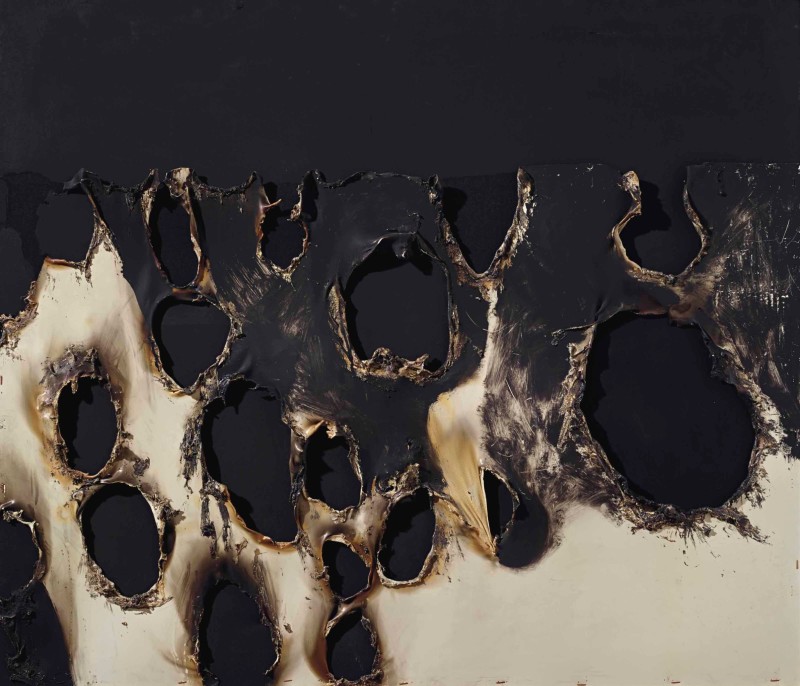Alberto Burri: Combustion, Destruction and Beauty
By Magdalena Polak
Looking at Alberto Burri’s works from the series Combustioni plastica, one is immediately confronted with its sheer brutality and physical properties. And yet, there is something completely human and organic about it.
Born in 1915 in Italy, Burri initially aspired to be a doctor. While working as a military doctor during World War II, he was captured and sent to a prisoner-of-war camp in Texas. It was there that he started to experiment with art and, due to the lack of proper painting materials, he used found materials, such as burlap, coal tar or oil. This practice started out of sheer necessity, but would become his signature artistic style. After his release and return to Rome in 1946, Burri decided to dedicate his life to art and, inspired by Jean Dubuffet’s use of “dirty materials”, incorporated unorthodox materials to create his abstract works.
Alberto Burri, Combustioni Plastica, 1956, mixed media, 85.7 × 100.0cm.
https://www.artbasel.com/catalog/artwork/55086/Alberto-Burri-Combustione-Plastica
His Gobbi series, which he started in 1950, marks his interest in breaking the restrictive two-dimensional space of picture planes, as well as the coalescence of different “multi-materials” taken from the real world. The idea was the focusing on materials’ individual properties and manipulating them so that they would become something completely different. The term "Gobbi" means “hunchback”, a play on the picture-plane being bent out of shape and approaching the viewer. Just as in Combustioni plastica, there is an element of brutality, as the canvases threaten to split under the stretching. The viewer is left anticipating the combustion of the work, the threat of the climax, which never occurs.
Alberto Burri, Ferro SP, 1961, welded iron sheet metal, oil, and tacks on wood framework, 130 x 200cm, Galleria nazionale d’arte moderna e contemporanea, Rome.
https://www.inexhibit.com/marker/nyc-alberto-burri-major-retrospective-guggenheim-museum/
Burri’s artistic work was, unfortunately, not well received internationally until J. J. Sweeney, director of the Solomon Guggenheim museum in New York, bought one of his works. His work was included in the group exhibition "Younger European Painters" at the Guggenheim in 1953. It was roughly at this time that Burri started experimenting with fire.
Although he initially focused on burning wood, much more traditional in the sense that he used organic material to produce an organic act, he soon moved on to the juxtaposition of an organic action on artificial material, namely plastic.
The first important element of the Combustioni plastica series is that Burri forsook all artistic devices to produce this work. He did not use a paintbrush; neither did he use a canvas in a traditional sense. The flaming torch became his paintbrush, while the enduring, but at the same time fragile, plastic became his canvas. Looking at photographs taken while he was working, he resembles an industrial worker, and the process resembles the welding of metal.
The way he chose to display the finished works hints at a Postmodern artistic temperance; they were not hanging on a wall, but suspended from a ceiling, so that the spectator could look through the transparent plastic and the holes; perceiving a world through burnt material. Through this act, Burri juxtaposes the idea of burnt and destroyed material with lightness and transparency. Part of this is, no doubt, the Greek idea of "catharsis"; the element of purging oneself of duress and being able to see more clearly through, or after, the act of distress and destruction. Just like in the Gobbi series, the presentation of the works suspended from the ceiling, but also the element of attacking the “canvas”, is a continuation of breaking the two-dimensionality of art.
At first glance, it appears that these works of burned plastic imply destruction, and come across as aggressive; conveying the feeling of having been produced by an uncontrolled force. However, what appears to have been produced uncontrolledly has actually been subject to meticulous, concentrated work.
Burri had surgical experience and, like a surgeon, he needed to have a thorough understanding of the material at hand, since, when working with flame, he needed to be thorough and swift and not hesitate; just like during a surgical operation. Working with plastic is a difficult enterprise due to the inflammable properties of the material, proving that the style required technique. At this point, it seems worth mentioning that his works often draw allusions to the human body; in this case, there is the reminiscence of burns on human skin.
The Combustioni plastica series therefore balances the idea of changing materials’ properties, as well as defying fire’s randomness in destruction. Finally, there is this element of wishing to dominate chance; Burri takes something that is, in its nature, unpredictable, and attempts to master it. This alone is drawing upon humanity’s undying wish to conquer the unconquerable; learning to fly, taming a wild animal, in short, changing the laws of nature.
Bibliography:
Rylands, Philip. Peggy Guggenheim Collection. New York, NY, Guggenheim Museum, 2004.
Guggenheim profile "Alberto Burri" Accessed 9th Sept. 2017. www.guggenheim.org/artwork/artfist/alberto-burri.




